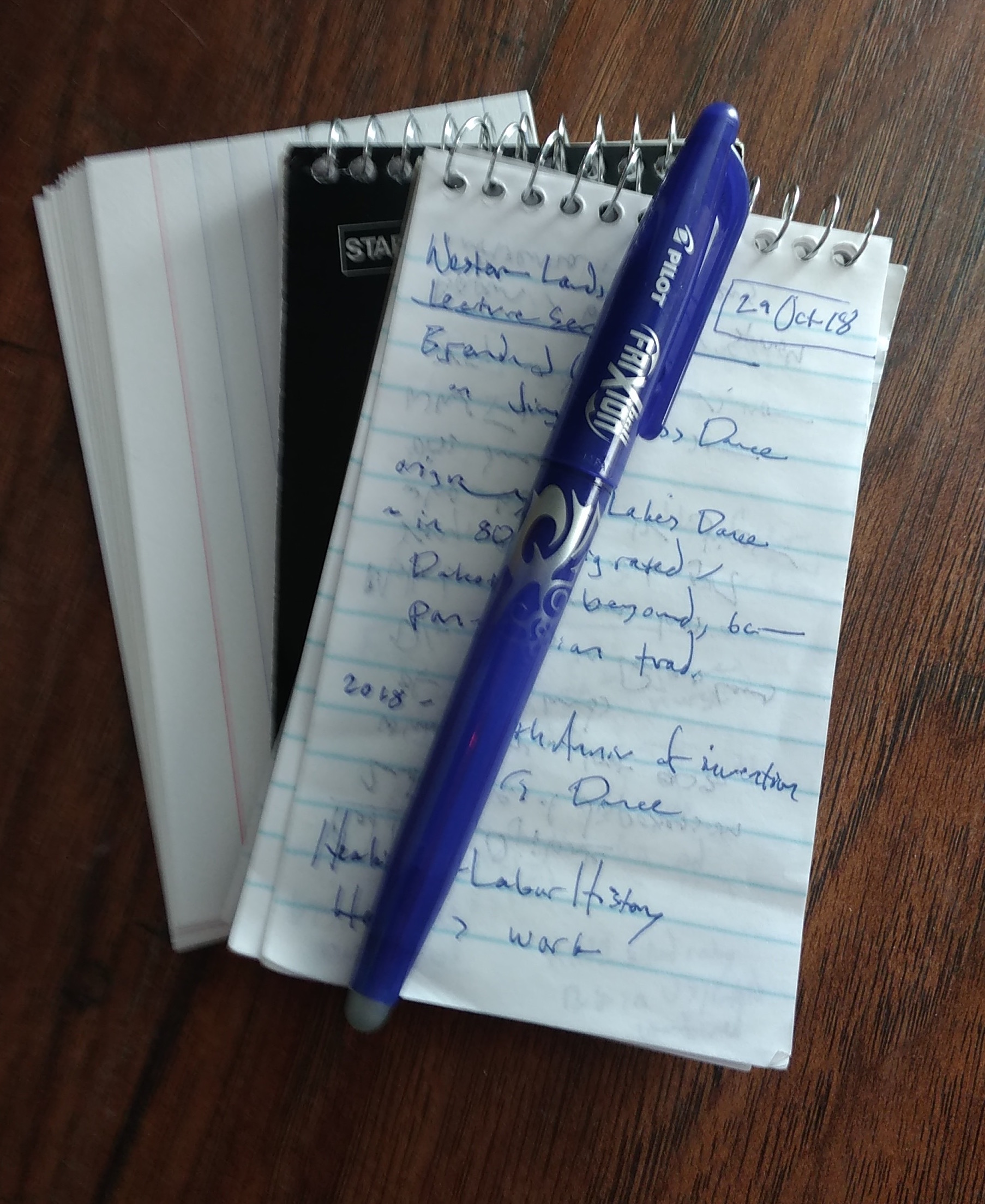I’ve had a lot of client inquiries about the not-so-simple task of managing all the physical paper we still use in the writing process–and how to manage multiple digital draft files too. Here are the tools I use to help organize myself on a daily basis.
- Index Cards & Mini Notebooks
Digital Equivalent: Smart phone “notes app”
Author Anne Lamott recommends index cards for their portability and for the fact that they don’t make your pants look “bunchy” when they’re in your back pocket. I’m partial to mini notebooks for the fact that they let me write in a little longer form if needed. I tolerate the bunchiness.
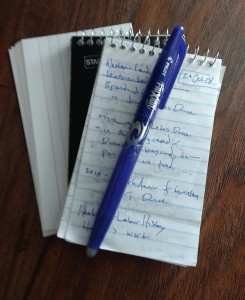 Whichever you prefer, the point is portability. Ideas, scenarios, and perfect sentences often come to you at moments of right-left brain unity. This usually happens while you’re doing a task that’s so familiar you can do it in auto-pilot. Hence, ideas come to you while washing the dishes, walking the dog, brushing a child’s hair, and during countless automatic tasks associated with driving—turning a key, pausing at a stop sign, turning a corner into a familiar neighborhood. All of a sudden, there’s the sentence you need for that pesky scene, the perfect way to describe how she brushed her bangs out of her eyes. Pull over. Reach for an index card. You’re ready.
Whichever you prefer, the point is portability. Ideas, scenarios, and perfect sentences often come to you at moments of right-left brain unity. This usually happens while you’re doing a task that’s so familiar you can do it in auto-pilot. Hence, ideas come to you while washing the dishes, walking the dog, brushing a child’s hair, and during countless automatic tasks associated with driving—turning a key, pausing at a stop sign, turning a corner into a familiar neighborhood. All of a sudden, there’s the sentence you need for that pesky scene, the perfect way to describe how she brushed her bangs out of her eyes. Pull over. Reach for an index card. You’re ready.
Index cards and mini notebooks are also low pressure in terms of word count. Perhaps you’re at the very start of a project when ideas are coming in fragmented form. Perhaps life is genuinely frenetic, and the moments you carve out for writing are between medical appointments for your parents and soccer practice for the kids. You can’t put pressure on yourself to write even a thousand words a day at this point. But you can write two sentences that summarize a scene. Which will serve as the prompt you need to write the full scene a year from now.
When to Use:
Throughout the book or article-writing process (because you never know when a fresh sentence will come to you), but especially in the initial idea-generating stage. When you’re just starting out in a project, ideas come to you at truly inconvenient moments. You have to be ready to play catch.
- Longhand Notepad
Digital Equivalent: Word document on a laptop or tablet (Sort of; there’s actually no digital equivalent. Read on to understand why.)
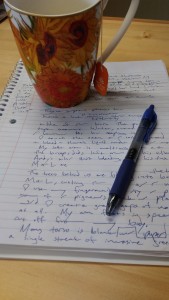 The full size notebook is still fairly portable, though a little clunky. At home, or in a library or coffee shop, it’s perfect for writing longer more sensitive scenes. While many of us type much faster than we handwrite, there are scenes that I find require longhand drafting first. There’s good reason for that. Apparently handwriting activates the brain in a holistic right-and-left hemisphere fashion, almost like meditation. If you’re stymied on a scene that you’ve been trying to type on your computer, set the laptop aside and pick up a notepad and pen.
The full size notebook is still fairly portable, though a little clunky. At home, or in a library or coffee shop, it’s perfect for writing longer more sensitive scenes. While many of us type much faster than we handwrite, there are scenes that I find require longhand drafting first. There’s good reason for that. Apparently handwriting activates the brain in a holistic right-and-left hemisphere fashion, almost like meditation. If you’re stymied on a scene that you’ve been trying to type on your computer, set the laptop aside and pick up a notepad and pen.
When to Use:
During longer writing stints—at least 20 to 30 minutes. Perfect for coffee shop writing and rainy day drafting.
Read more about the surprising value of long-hand drafting:
Three Ways that Handwriting with a Pen Positively Affects Your Brain
The effects of handwriting experience on functional brain development in pre-literate children
- Hanging File Folders & Individual Divider Folders
Digital Equivalent: Computer Desktop Folders & Subfolders
As you accumulate index cards and sheets of long-hand drafted scenes, you’ve got to put them somewhere. I’ll admit I’m the worst when it comes to stacking things in the office. Rats; I put it… somewhere here. At some point there’s a critical mass of handwritten scenes and notes. It’s time to organize.
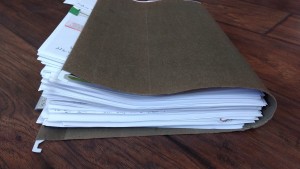
This hanging file folder full of ideas and early drafts is definitely ready for the next stage: the 3-ring binder.
In the earliest stages, it’s a single hanging file folder with the project name on it. About half a dozen divider files sit inside that for the main parts of the book. If the work is narrative (story-based, not instructional non-fiction), I do not write chapter numbers on these subfolders. That’s important. Most narrative writers don’t know their chapter breaks till they’re at a semi-final revision stage. Organize instead by “parts”, rough sections within the plot. One of my projects has subfolders labeled: Escape, Hitchhiking, Settling In, Trouble, New Threats, Everything Crumbles. You get the idea.
If your book is instructional/informational non-fiction, you will hopefully have crafted a detailed outline before starting your first draft. In this situation, it’s completely appropriate to title your subfolders with chapter names and numbers.
When to Use:
At the very outset of your project, so you have a place to immediately file all those index cards and long-hand draft sheets. Or, if you’re like me, a few months into the process when you’re sick of accumulating the shreds of scenes on every table, desk, and counter in your house.
- Three-Ring Binders
Digital Equivalent: PDF version shared via email
Over time, the collection of scenes and partial scenes in your file folders will grow. The hope is to take a longer stint, an afternoon or a day or a whole week, with each of those subfolders. Transcribe the longhand drafts and stitch the scene fragments together. In that process, chapters and partial chapters form. It’s time to print out several of these sections and see how they flow together when read consecutively. Then you can note areas where you still have content gaps–missing scenes, transitions still needed.
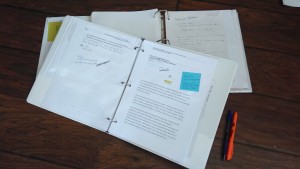 Whether you need to do a red-pen read-through yourself or you want to share a copy with a beta reader, the three-ring binder will come into play at some point. It’s that first step toward testing how the pages flow into each other. It’s also courteous to provide your work, printed and contained in a 3-ring binder, when sharing it with editors. Most editors work off the printed document rather than the digital format. Be sure to ask about your editor’s preferences.
Whether you need to do a red-pen read-through yourself or you want to share a copy with a beta reader, the three-ring binder will come into play at some point. It’s that first step toward testing how the pages flow into each other. It’s also courteous to provide your work, printed and contained in a 3-ring binder, when sharing it with editors. Most editors work off the printed document rather than the digital format. Be sure to ask about your editor’s preferences.
When to Use:
When you’re ready to conduct your own full read through of the book or several completed sections of the book (hard-copy print is best for this task to minimize eye strain). When you’re ready to share a copy of the full manuscript with a beta reader or editor.
- As for Digital File Naming and Filing…
My protocol for digital file naming is pretty simple. Once I’ve established the rough parts or “acts” within my book (usually 5 to 7 sections), I create a main desktop folder for the book project. Within that main folder are subfolders titled with the names of each act. (As mentioned above in my comments about physical folders, I only use chapter numbers when the work-in-progress is non-fiction instructional/informational.)
- My word documents within these subfolders, are saved with 1- or 2-word titles that vividly describe their dominant scene. (i.e. StealingCar, SwimmingDog, MothersHatchet, etc.)
- Following that title tag is a version tag (v01a, v01b, v02a, etc.).
- Sometimes I use initial number tags (01, 02, etc.) in the file names to begin roughly arranging the order of the scenes within a given part of the book.
That protocol results in file lists that look like this.
Folder: Act02-Arrival contains these word documents:
01-SettlingIn-v01a
01-SettlingIn-v02a
01-SettlingIn-v02b
01-SettlingIn-v02c
02-TrailCleanup-v01a
02-TrailCleanup-v01b
02-TrailCleanup-v02a
04-HelenFirstConflict-v01a
I’ve had projects with up to a dozen significant scene rewrites. I regularly preserve older drafts and then “save-as” a new version with an updated version tag. I do this anytime I’m about to make significant additions or removals or fully rewrite for point-of-view or tense. It’s invaluable to have the option to go back to an old version if I change my mind about that rewrite three months from now. As long as I’m diligent about saving new versions with new file names, I am able to do just that.
Yes… There is software, like Scrivener, which can provide this kind of draft management for you. I’m not crazy about Scrivener, but that’s purely personal preference. It might work well for you. Go for it! What’s important is choosing an organizing system that works smoothly for you. If you decide to use software to do that, just make sure it can easily “export to Word Doc”. Most editors, agents, and publishing houses will require your manuscript submission in Word Document form.
When to Use:
As soon as you start typing drafts on your computer. The sooner you create a file organizing protocol, the better!

